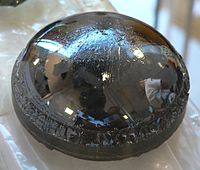
Photo from wikipedia
In this study, it is observed that boron-doped float-zone silicon coated with hydrogenated silicon nitride shows strong instabilities in effective minority carrier lifetime after a fast firing step and subsequent… Click to show full abstract
In this study, it is observed that boron-doped float-zone silicon coated with hydrogenated silicon nitride shows strong instabilities in effective minority carrier lifetime after a fast firing step and subsequent treatment at elevated temperatures and illumination. During such a treatment, both degradation and recovery features are visible over time scales from minutes to months. To further investigate the observed behavior, corona charging series, capacitance voltage measurements, and chemical repassivation methods are applied. It is shown that a first fast degradation and recovery is associated with changes in the bulk lifetime, and it is observed that the fast firing step strongly influences this bulk instability. A subsequent slower degradation and recovery reflects changes in the effective surface recombination velocity that can be attributed to changes in the chemical passivation quality. It can be concluded that care has to be taken when boron-doped float-zone silicon is used as a supposedly stable high lifetime reference material after a fast firing step. Additionally, it can be stated that a silicon nitride related passivation may be far from stable at elevated temperatures and illumination after a fast firing step.
Journal Title: IEEE Journal of Photovoltaics
Year Published: 2017
Link to full text (if available)
Share on Social Media: Sign Up to like & get
recommendations!